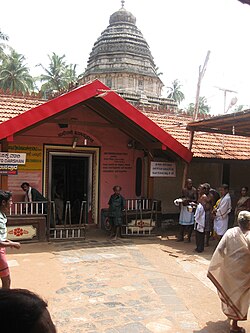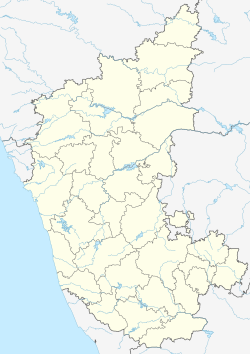Top Qs
Timeline
Chat
Perspective
Mahabaleshwar Temple, Gokarna
Hindu temple in Karnataka state, India From Wikipedia, the free encyclopedia
Remove ads
The Mahabaleshwar Temple, Gokarna is a 4th-century-CE Hindu temple in Gokarna, Uttara Kannada district, Karnataka state, India, built in the classical Dravidian architectural style. It is a site of religious pilgrimage. The temple faces the Gokarna beach on the Arabian Sea. The temple deifies the Pranalinga ("the reality of God which can be captured by the mind") also called Atmalinga or Shiva Linga[1] In legend, it is said that the deity of the temple will bestow immense blessings to devotees, even to those who only have a glimpse of it.[2][3] Currently, the administrative charge of the temple is with an Overseeing Committee under the Chairmanship of Justice BN Srikrishna, a Retired Justice of the Hon'ble Supreme Court of India.[4] It is one of the 275 paadal petra sthalams expounded in the Tevaram, a sacred Tamil Shaivite text written during the 6th and 7th centuries by 63 saints called Nayanars.[5]
Remove ads
Remove ads
Introduction
The temple is one of the seven sacred Muktikshetras or Muktistala ("places of salvation") in Karnataka. It is a place where many Hindus of Karnataka perform obsequies (death rites) for their departed. The six other Muktikshetras in Karnataka are at Udupi, Kollur, Subrahmanya, Kumbasi, Koteshvara and Sankaranarayana.[6][7] The classical Sanskrit writer, Kalidasa mentions the "Lord of Gokarna" in his 4th-century work, Raghuvamsha.[citation needed]
The temple is a large complex of shrines and much of it belongs to the later Vijayanagara period (1336–1646 CE).[citation needed]
In 1676, Fryer, an English traveller, visited Gokarna during the Maha Shivaratri festival and wrote in detail about it.[8]
Remove ads
Location
The temple is located on the shores of Arabian Sea on the west coast of India, near the city of Karwar. It is in the town of Gokarna in Uttara Kannada (or North Kannada district).
Gokarna lies between the Gangavalli and Aganashini rivers.[3][9]
Legend
Summarize
Perspective

The hoary legend of the temple as narrated, links Ravana of the Ramayana, the demon king of Lanka, not only to the Shiva Linga deified in the Mahabaleshwar Temple but also to Gokarna's Bhadra Kali temple. The legend also provides etymology of the place name, "Gokarna".[10]
Ravana's mother, a staunch devotee of Lord Shiva, was worshipping a Shiva Linga to bring prosperity to her son. Indra, the Lord of Heaven, who was jealous of this worship, stole the Shiva Linga and threw it away into the Sea. The distraught mother of Ravana went on a hunger strike as her devotional worship of Shiva was disrupted.
Ravana then promised his mother that he would go to Mount Kailash, the abode of Lord Shiva, and bring the main Atmalinga itself for her worship. Ravana then performed severe penance at Mount Kailash to please Lord Shiva and also sang, in his melodious voice, praises of Shiva (Shiva Tandava Stotram). He even chopped his own head, and made a harp with threads drawn from his skin and intestine. Lord Shiva was pleased and he appeared before him and offered a wish. Ravana requests the Atmalinga as his boon. Lord Shiva agrees to give him the boon, as per the wish of Ravana that the Atmalinga cannot to stolen or removed by anyone, with a condition that wherever the Atma-Linga is placed on the ground, it would remain rooted at that spot forever. Having obtained his boon, Ravana started back on his journey to Lanka.
As Ravana was nearing Gokarna, Lord Vishnu blotted out the sun to give the appearance of dusk. Ravana now had to perform his evening rituals but was worried because with the Atma-Linga in his hands, he would not be able to do it. At this time, Lord Ganesha in the disguise of a Brahmin boy accosted him. Ravana requested him to hold the Atma-Linga until he performed his rituals, and asked him not to place it on the ground. Ganesh struck a deal with him saying that he would call Ravana thrice, and if Ravana did not return within that time, he would place the Atma-Linga on the ground.
Ganesha called out thrice rapidly but Ravana couldn't come within the specified time. Even before Ravana could return, Lord Ganesha placed the Atmalinga on the ground, tricked Ravana and vanished from the scene with his cows. Ravana then chased the only cow, which was going underground. However, he managed to get hold of the cow's ear, as the rest of cow's body had disappeared below ground. It is this ear now seen in a petrified form, which has given the name "Gokarna" to the place. The word "Gokarna" means "cow's ear" where in Sanskrit gow means "cow" and karna means "ear".[7][11][12]
Then, Ravana tried hard to lift the Shiv Linga but failed as it was firmly fixed. Ravana had even fainted; thereafter he gave the name "Mahabaleshwar" (meaning all-powerful) to the Atmalinga.[11] Thus, according to the legend narrated, the place now boasts of three divine entities namely: Gokarna, the cow's ear; the Atmalinga or Shiva Linga that is deified in the Mahabaleshwar Temple; and the Goddess Bhadrakali, which are all now divine places of worship integral to Gokarna.[13]
Remove ads
Temple structure
Left: Dravidian style Gopura of Mahabaleshwar temple at Gokarna. Right: Pradakshinapath (circumambulatory path) of Mahabaleshwar temple at Gokarna.
The temple is built of granite in the Dravidian architectural style. The Atmalinga is enshrined in the temple on a square Saligrama Peetha (pedestal). The pedestal has a small hole at its centre from where devotees can see the top of the Atmalinga.
Foreigners, including practicing Hindus of non-Indian (Western) origin are not allowed to enter the sanctum-sanctorum and see the Shivalinga.
Remove ads
Festival
The Shivaratri festival, the observance of the union of Lord Shiva and Goddess Parvati is celebrated in Gokarna on the 14th day of the dark fortnight in the month of Magha, coming either in February or March, when a very large number of pilgrims visit the shrine. During the festival, a Rath Yatra (a procession in a large wooden chariot) is held. Images of Shiva and other deities are installed in a chariot which is ceremoniously pulled through the town by the devotees, accompanied by drum bands. The Ratha Yatra starts from the Shri Maha Ganapati temple at the terminus of the main market street, also known as "Car Street".[9][14]
Remove ads
References
Wikiwand - on
Seamless Wikipedia browsing. On steroids.
Remove ads




